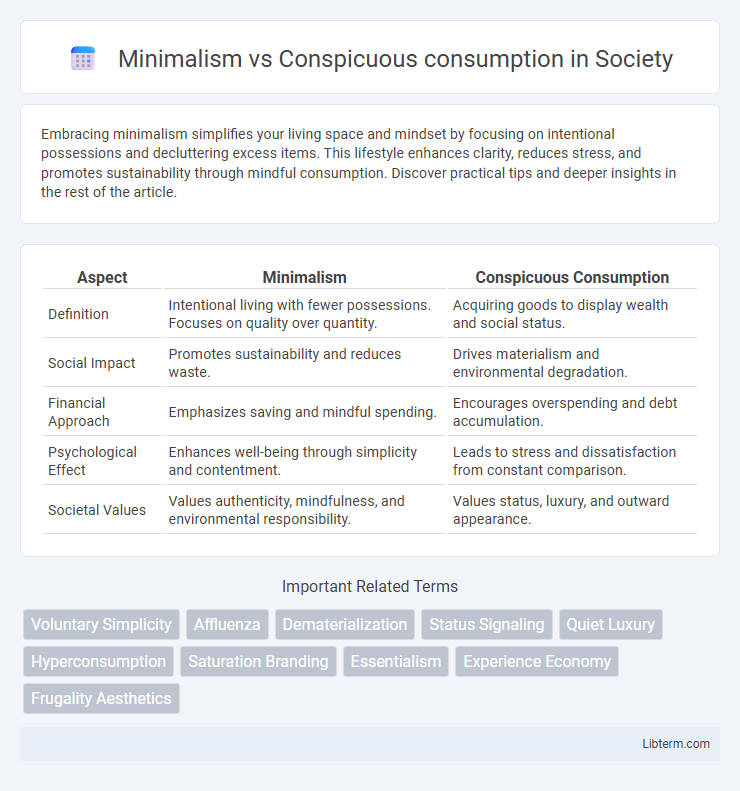Embracing minimalism simplifies your living space and mindset by focusing on intentional possessions and decluttering excess items. This lifestyle enhances clarity, reduces stress, and promotes sustainability through mindful consumption. Discover practical tips and deeper insights in the rest of the article.
Table of Comparison
| Aspect | Minimalism | Conspicuous Consumption |
|---|---|---|
| Definition | Intentional living with fewer possessions. Focuses on quality over quantity. | Acquiring goods to display wealth and social status. |
| Social Impact | Promotes sustainability and reduces waste. | Drives materialism and environmental degradation. |
| Financial Approach | Emphasizes saving and mindful spending. | Encourages overspending and debt accumulation. |
| Psychological Effect | Enhances well-being through simplicity and contentment. | Leads to stress and dissatisfaction from constant comparison. |
| Societal Values | Values authenticity, mindfulness, and environmental responsibility. | Values status, luxury, and outward appearance. |
Understanding Minimalism: The Philosophy of Less
Minimalism emphasizes intentional living by prioritizing quality over quantity, reducing possessions to essentials that add genuine value. It challenges conspicuous consumption, which is driven by the desire to display wealth through excessive material goods, often leading to waste and dissatisfaction. Embracing minimalism fosters sustainability, financial freedom, and mental clarity by focusing on meaningful experiences rather than material excess.
What Is Conspicuous Consumption?
Conspicuous consumption refers to the practice of purchasing goods and services to publicly display wealth and social status rather than for intrinsic value or necessity. This behavior often involves luxury items such as designer clothing, expensive cars, and lavish experiences designed to signal prestige. Conspicuous consumption contrasts sharply with minimalism, which emphasizes intentional living, simplicity, and reducing material possessions to enhance quality of life.
Historical Roots of Minimalism and Conspicuous Consumption
Minimalism traces its historical roots to early 20th-century art movements like Bauhaus and Japanese Zen philosophy, emphasizing simplicity, functionality, and mindfulness to counter industrial excess. Conspicuous consumption emerged from Thorstein Veblen's 1899 theory, describing affluent societies' display of wealth through extravagant spending to signal status and power. These contrasting origins highlight minimalism's focus on intentional living versus conspicuous consumption's aim to project social prestige through material abundance.
Societal Influences on Lifestyle Choices
Societal influences heavily shape lifestyle choices by promoting either minimalism or conspicuous consumption through cultural values, social status, and peer pressure. Minimalism emphasizes intentional living, sustainability, and reduced materialism, often adopted in response to environmental concerns and rising discontent with overconsumption. Conspicuous consumption, driven by social signaling and consumer culture, encourages status-driven purchases and the accumulation of luxury goods to display wealth and success.
The Psychological Impact of Minimalism
Minimalism reduces cognitive overload by promoting intentional choices and physical decluttering, which decreases stress and increases mental clarity. Studies show that minimalist environments enhance emotional well-being by fostering mindfulness and reducing anxiety linked to material possessions. In contrast to conspicuous consumption, minimalism encourages intrinsic satisfaction, leading to long-term psychological resilience and fulfillment.
Social Status and the Drive for Conspicuous Consumption
Conspicuous consumption serves as a social signal, showcasing wealth and status through the acquisition of luxury goods, often driven by the desire to impress peers and gain social acceptance. Minimalism rejects this pursuit, emphasizing intentional living and valuing experiences or essentials over material possessions, which challenges traditional markers of social status. The drive for conspicuous consumption is fueled by societal pressures and advertising that link self-worth and prestige to visible displays of wealth.
Environmental Consequences: Minimalism vs Consumption
Minimalism significantly reduces environmental impact by minimizing waste, lowering carbon footprints, and promoting sustainable resource use. Conspicuous consumption drives overproduction, increases landfill waste, and accelerates resource depletion, exacerbating climate change. Embracing minimalism leads to more efficient energy use and less pollution, supporting long-term ecological balance.
Financial Implications: Saving vs Spending
Minimalism encourages deliberate spending and prioritizes saving by reducing unnecessary purchases, leading to increased financial security and long-term wealth accumulation. Conspicuous consumption drives higher spending on luxury goods to display status, often resulting in debt and diminished savings. Financially, minimalism supports sustainable budgeting and investment, whereas conspicuous consumption may undermine financial stability through impulsive expenditures.
Minimalism, Well-Being, and Life Satisfaction
Minimalism emphasizes intentional living by reducing material possessions, which enhances well-being through decreased stress and increased focus on meaningful experiences. Studies show that individuals practicing minimalism report higher life satisfaction due to improved mental clarity and financial freedom. Prioritizing quality over quantity fosters sustainable habits that align with personal values and promote long-term happiness.
Choosing Your Path: Finding Balance Between Minimalism and Conspicuous Living
Choosing your path between minimalism and conspicuous consumption involves evaluating personal values and financial goals to create a balanced lifestyle. Emphasizing intentional spending and mindful ownership helps avoid the pitfalls of excessive materialism while still allowing for meaningful purchases that enhance well-being. This balance fosters financial health and emotional satisfaction by aligning consumption habits with long-term priorities rather than societal pressures.
Minimalism Infographic

 libterm.com
libterm.com